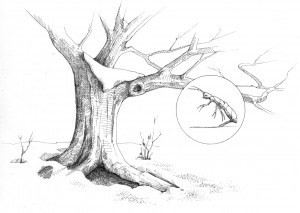
With winter breaking up and spring on its way, I spied a small pool of water glinting in the sunlight where meltwater seeps across a meadow. The pool’s surface was speckled by hordes of blue-black motes, lending a sooty texture to the water.
I bent to inspect. Instantly, the specks vanished, only to reappear a foot or two away on neighboring pools and grass. They sprang off the water silently, without making the least dent or ripple.
I captured a single individual in a plastic vial and found it to be a tiny creature, a springtail – or snow flea – no more than two millimeters long that required a strong magnifier to see clearly.
Greatly enlarged, my little water springtail had unexpected beauty, its dark body clothed in highly reflective bluish scales, dispelling the dull, sooty appearance the insects present to the naked eye.
Springtails are so odd and primitive that they are not considered true insects. Instead, they are classified as hexapods, the overall group of six-legged invertebrates from which insects later evolved. Springtails have been around a long time, for their fossils have been recovered from Devonian rocks over 395 million years old, laid down long before insects appeared on the scene.
The water springtails (Podura aquatica) on my pool are but one species among the springtail group that numbers over 6,000 different kinds. Other springtails inhabit woodland leaf litter and old logs, rain forest canopies, rocky shorelines, tree bark, beaches, soil, meadows, deserts, snow, and the ice of Antarctica, the Himalayas, and just about everywhere else. I’ve found them at high altitudes on the still-warm lava of active volcanoes, deep in caves, and hidden in aerial roots of tropical rain forest epiphytes. Springtails are the most widely distributed hexapods on Earth, so abundant that their populations can exceed 100,000 individuals per square meter. Despite this, they are almost never seen by humans, overlooked because of their elusive nature and small size. But on the surface of a New England pool in springtime, their numbers are staggeringly apparent.
A water springtail’s undistinguished, elongated, rather lumpy body belies a hidden marvel of engineering. Because it lacks wings and its eight eyes are unremarkable, the creature appears to be unadorned. The six-segmented abdomen also seems featureless—except for an extraordinary device folded beneath the body. It takes careful inspection with a powerful magnifier to make out what it is.
Think of a mousetrap, the common sort where you fold a spring-powered bar until it catches under a trigger. There it remains under tension until the trigger is touched, then the bar slams shut—unluckily for mouse or misplaced finger. If I turn a cocked mousetrap upside down and place it gently on it a table, it becomes a perfect replica of a springtail’s jumping apparatus. Poke it with a stick and watch the mousetrap leap high into the air.
A springtail’s forked, lever-like appendage, the furcula, is hinged on the abdomen’s fourth segment. Bent forward, it is securely gripped by a clasp known as the tenaculum, located on the third segment. It remains there under tension as the springtail walks around feeding on fungi, algae, pollen, bacteria, and bits of organic matter. Potential energy in the furcula comes from hydrostatic pressure in the tiny animal’s body fluids.
At the least alarm, the tenaculum releases the furcula, which snaps open instantly. The lever hits the surface with such force that it sends the little animal flying into the air. Because small size means near-weightlessness, a springtail leaps to heights at least a hundred times its own body length. Seeing them vanish from the pool’s surface, and magically reappear elsewhere, is enough to make me doubt my senses.
Another odd feature on the underside of a springtail’s abdomen is a knob that sticks down from the first segment in front of the tenaculum. Botanists used to think it was an organ of attachment, perhaps a suction cup, that allowed a springtail to remain fixed to a surface before leaping away.
Now the knob – or collophore – is recognized as an organ of water absorption, independent of the mouth, that absorbs water through osmosis and regulates water balance in the furcula. The collophore gives the springtail the ability to increase fluid pressure in the furcula lever, readying it for the next jump to safety. A water springtail can jump repeatedly, but only if the hydrostatic pressure within the furcula is immediately re-established after each leap.
Eating, leaping, molting, growing, mating—it’s a busy life. And one that can go on for a while, since water springtails hibernate through our northern winters and, in this cold climate, may live for several years. Not surprising for creatures that have already been around for 400 million years.


Discussion *